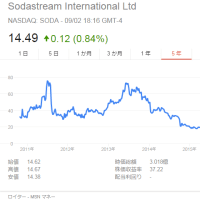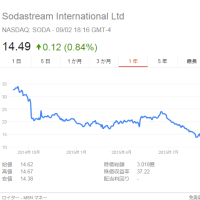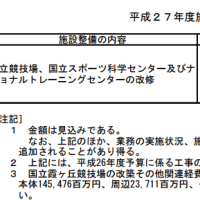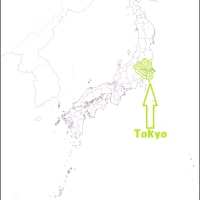一昨日、オーストラリア政府が日本政府が行ってる南極海「調査捕鯨」の中止を求める訴えに関する判決が国際司法裁判所(ICJ)で行われ、南極海「調査捕鯨」は「科学的」でないとして国際捕鯨委員会(IWC)の条約違反と判定→日本政府が持ってた南極海「調査捕鯨」の許可を取り上げる判決が下された。
この判決について、予想通りというかなんというか天下の3K新聞が意味のわからない非難を行っていた。
・国際捕鯨裁判 生態把握の手段が消える(2014年4月2日 MSN産経ニュース)
一昨日の判決は3K新聞的には相当ショックだったかもしれないとはいえ、読んでるこっちが心配になるこの論説。
以下、2014年4月2日分 MSN産経ニュース『国際捕鯨裁判~』から序盤部分を(略
---- 以下引用 ----
明らかに公平さと合理性を欠いた結論だ。
日本が国際捕鯨取締条約に基づいて南極海で行ってきた調査捕鯨に対し豪州が中止を求めて国際司法裁判所(ICJ)に提訴していた裁判で、日本の活動を条約違反とする判決が下された。
ICJの判決には上訴の手段がなく、日本政府は従わざるを得ないが、鯨類の生態解明などに貢献してきた調査捕鯨の科学性が十分に理解されなかったことは、極めて遺憾だ。
日本は世界に向けて、これまで以上に調査捕鯨の意義を明確に説明しなければならない。
そうしなければ「科学を装った商業捕鯨」という豪州や反捕鯨団体による不当な誹謗(ひぼう)が定着してしまう。
(以下略)
---- 引用以上 ----
冒頭の見解は論外として・・・。
一昨日の判決が示したのは、あくまで南極海「調査捕鯨」(JARPA II)の非科学性であり、それ以外の(北太平洋沖合における)「調査捕鯨」については問題視していない(今回の裁判の対象外だけど)。
とはいえ、日本政府が今更南極海「調査捕鯨」の意義を語っても何の説得力もないし、語れば語るほどそれ以外の「調査捕鯨」の信頼性にも影響を与えるだけじゃ?
その意味では、上の引用部分における「調査捕鯨の意義を明確に説明」云々という主張は的外れだわな。
しかし、この後、3K新聞の論説では、判決結果について変な解釈を行っていた。
以下、2014年4月2日分 MSN産経ニュース『国際捕鯨裁判~』からさっきの引用部分の続きを(略
---- 以下引用 ----
(中略)
日本の敗訴理由のひとつは、調査捕鯨の捕獲目標数と実際の捕獲頭数の開きである。
南極海での調査捕鯨の主な対象はクロミンククジラで、日本は約800頭の捕獲枠を持っているが、実際の捕獲は昨漁期の場合、約100頭に減っている。
これは調査計画がずさんであったためではなく、反捕鯨団体の執拗(しつよう)で悪質な妨害があったからである。
あえて強硬策を避けた日本の配慮が裏目に出た形だ。
判決を機に、鯨を神聖視して感情に訴える反捕鯨団体の活動が、北西太平洋での調査捕鯨に対してもエスカレートすることが危惧される。
(以下略)
---- 引用以上 ----
↓判決本文。
・Judgment Merits(2014年3月31日 icj-cij.org;.pdfファイル)
確かに、判決では、南極海「調査捕鯨」における捕獲数の減少について Sea Shepherd の抗議活動の影響を認めてはいる。
ついでに、捕獲数減少が調査結果の信頼性に影響を与えていることも。
参考までに、2014年3月31日分 icj-cij.org『Judgement Merits』からP.63の一部を(略
---- 以下引用 ----
(中略)
206. Taking into account all the evidence, the Court considers that no single reason can explain the gap between the target sample sizes and the actual take.
As to humpback whales, the gap results from Japan’s decision to accede to a request from the Chair of the IWC but without making any consequential changes to the objectives or sample sizes of JARPA II.
The shortfall in fin whales can be attributed, at least in part, to Japan’s selection of vessels, an aspect of the design of JARPA II criticized by the expert called by Japan (see paragraph 180 above).
As to the fire on board a ship in one season, Japan did not provide information regarding the extent of the damage or
the amount of time during which the vessel was compromised.
The Court considers it plausible that sabotage activities could have contributed to the lower catches of minke whales in certain seasons, but it is difficult to assess the extent of such a contribution.
In this regard, the Court notes that the actual take of minke whales in the 2006-2007 and 2007-2008 seasons was 505 and 551, respectively, prior to the regrettable sabotage activities that Japan has brought to the Court’s
attention.
In this context, the Court recalls IWC Resolution 2011-2, which was adopted by consensus.
That resolution notes reports of the dangerous actions by the Sea Shepherd Conservation Society and condemns “any actions that are a risk to human life and property in relation to the activities of vessels at sea”.
(中略)
209. The Court observes that, despite the number of years in which the implementation of JARPA II has differed significantly from the design of the programme, Japan has not made any changes to the JARPA II objectives and target sample sizes, which are reproduced in the special permits granted annually.
In the Court’s view, two conclusions can be drawn from the evidence regarding the gap between the target sample sizes and actual take.
First, Japan suggests that the actual take of minke whales does not compromise the programme, because smaller numbers of minke whales can nonetheless generate useful information, either because the time frame of the research can be extended or because less accurate results could be accepted.
The Court recalls, however, that the minke whale sample sizes for particular research items were based on a six-year research period and on levels of accuracy that were not explained in the JARPA II Research Plan or in these proceedings.
Japan’s statement that the programme can achieve scientifically useful results with a longer research period or a lower level of accuracy thus raises further doubts about whether the target sample size of 850 whales is reasonable in relation to achieving the stated objectives of JARPA II.
This adds force to Australia’s contention that the target sample size for minke whales was set for non-scientific reasons.
210. Secondly, despite the fact that no humpback whales and few fin whales have been caught during JARPA II, Japan’s emphasis on multi-species competition and ecosystem research as the bases for the JARPA II sample sizes for all three species is unwavering.
In the view of the Court, the gap between the target sample sizes for fin and humpback whales in the JARPA II Research Plan and the actual take of these two species undermines Japan’s argument that the objectives relating to ecosystem research and multi-species competition justify the larger target sample size for minke whales, as compared to that in JARPA.
(以下略)
---- 引用以上 ----
だが、そもそも、計画していた捕獲頭数自体大きな問題があった。
具体的には、なんで、800頭以上のミンククジラを捕獲するのか、という根本的な問題提起だが・・・。
以下、2014年3月31日分 icj-cij.org『Judgement Merits』からP.56の一部を(略
---- 以下引用 ----
(中略)
188. The evidence shows that the JARPA II Research Plan lacks transparency in the reasons for selecting particular sample sizes for individual research items.
This is a matter on which the experts called by the two Parties agreed, as described above (see paragraphs 158-159).
With the exception of one variable (discussed in the next paragraph), the JARPA II Research Plan provides very limited information regarding the selection of a particular value for a given variable.
For example, in the Court’s view, there is no consistent effort to explain why, for the various research items relating to the monitoring of biological parameters, JARPA II is designed to detect one particular rate or degree of change over another that would result in a lower sample size.
These shortcomings of the JARPA II Research Plan have particular prominence in light of the fact that the particular choices of rate and degree of change consistently lead to a sample size of approximately 850 minke whales per year.
189. An exception to this pattern is arguably the discussion of the sample size applicable to the study of the age at sexual maturity of minke whales, as to which the JARPA II Research Plan furnishes some details about the factors that Japan considered in selecting the particular rate of change to detect.
For this research item, the Research Plan also offers an indication of the relationship between the data sought and the first two JARPA II research objectives.
The Court finds no comparable reasoning given as to the five other research items that were expressly used to set the overall sample size of 850 whales (i.e., those research items set forth in Figure 5-4 from Japan’s Counter-Memorial above).
This highlights the absence of evidence, at least in the JARPA II Research Plan, that could support a finding that the sample size for the lethal take of minke whales, a key component of the design of JARPA II, is reasonable in relation to achieving the programme’s objectives.
190. The Court also recalls that one of the experts called by Australia, Mr. Mangel, asserted that nearly the same level of accuracy that JARPA II seeks could be obtained with a smaller lethal take of minke whales and further posited that a smaller take and higher margin of error might be acceptable, depending on the hypothesis under study.
Japan did not refute this expert opinion.
(以下略)
---- 引用以上 ----
無論、この裁判の公判で日本政府は、捕獲頭数の設定根拠を述べたが、「その先」について納得のいく説明は行われなかったわけで・・・。
また、捕獲頭数設定に関しては別の問題もある。
これについては、JARPA II の前身こと JARPA(1987年度~1994年度まで行われた南極海「調査捕鯨」)との関連も影響してるようだが・・・。
2014年3月31日分 icj-cij.org『Judgement Merits』から P.50-P.51の一部を(略
---- 以下引用 ----
(中略)
152. The Court notes that Japan states that “the research items and methods” of JARPA II are “basically the same as those employed for JARPA”, which is why “the explanation for the necessity of lethal sampling provided regarding JARPA also applies to JARPA II”.
Australia makes the point that “in practice Japan collects the same data” under JARPA II “that it collected
under JARPA”.
Japan also asserts broadly that both programmes “are designed to further proper and effective management of whale stocks and their conservation and sustainable use”.
153. Taken together, the overall research objectives of JARPA and JARPA II, as well as the subjects of study and methods used (i.e., extensive lethal sampling of minke whales) thus appear to have much in common, even if certain aspects differ.
These similarities cast doubt on Japan’s argument that the JARPA II objectives relating to ecosystem monitoring and multi-species competition are distinguishing features of the latter programme that call for a significant increase in the minke whale sample size and the lethal sampling of two additional species.
154. There is another reason to question whether the increased minke whale sample size in the JARPA II Research Plan is accounted for by differences between the two programmes.
As previously noted, Japan launched JARPA II without waiting for the results of the Scientific Committee’s final review of JARPA.
Japan’s explanation to the Court was that “it was important to keep the consistency and continuity in data obtained in the research area” and that waiting to commence JARPA II only following the final review of JARPA would have meant “no survey in one or two years”.
The JARPA II Research Plan also frames the monitoring of whale abundance trends and biological parameters as designed “to secure continuity with the data collected in JARPA”.
155. This emphasis on the importance of continuity confirms the overlap in the focus of the two programmes and further undermines Japan’s reliance on JARPA II’s objectives to explain the larger minke whale sample size in JARPA II.
Japan does not explain, for example, why it would not have been sufficient to limit the lethal take of minke whales during the “feasibility” phase of JARPA II (its first two years) to 440 minke whales, the maximum number of minke whales that were targeted during the final season of JARPA.
Instead, 853 minke whales were taken during the first year of JARPA II, in addition to ten fin whales.
This also meant that JARPA II began using the higher sample size for minke whales, and similar research methods (e.g., the examination of ear plugs to obtain age data and the examination of blubber thickness to assess nutritional conditions) without having yet received the benefit of any feedback from the final review of JARPA by the
Scientific Committee.
156. These weaknesses in Japan’s explanation for the decision to proceed with the JARPA II sample sizes prior to the final review of JARPA lend support to the view that those sample sizes and the launch date for JARPA II were not driven by strictly scientific considerations.
These weaknesses also give weight to the contrary theory advanced by Australia that Japan’s priority was to maintain whaling operations without any pause, just as it had done previously by commencing JARPA in the first year after the commercial whaling moratorium had come into effect for it.
(以下略)
---- 引用以上 ----
JARPA II で定めたミンククジラの捕獲頭数は、JARPA の結果を踏まえない非常にいい加減な設定によるものってことか。
となれば、根拠を示せと言われても説明できないのは自明のこと・・・。
ってのを踏まえれば、捕獲頭数の少なさについて「強硬策を避けた日本の配慮が裏目に出た形だ」なんて書く3K新聞は、根本の問題点を無視してると評価せざるを得ない。
そんなに、日本政府の責任を認めたくないんか?
そして、件の論説は、妄想全開のオチを用意していた。
以下、2014年4月2日分 MSN産経ニュース『国際捕鯨裁判~』から終盤部分を(略
---- 以下引用 ----
(中略)
日本が南極海の調査捕鯨から撤退すれば、主要鯨種の生息数や鯨種間の競合状況など資源管理の基本データが不足していく。
日本の鯨食文化にも影が差す。
世界の人口増加で、遠くない将来、動物性タンパク源として鯨類の本格利用が始まるだろう。
そのとき正確な資源情報がなければ、強国による乱獲が起こり得る。
継続性のある科学調査が必要だ。
---- 引用以上 ----
エイプリルフールは昨日なんだけど・・・。
それはそうと。
一昨日の判決を受けて、一部の国会議員の方々が意味不明なコメントをカマしていた。
・調査捕鯨敗訴で自民議連が決起?! 鯨肉入りカレーで気合い 政府対応の甘さに重鎮怒り(2014年4月2日 MSN産経ニュース)
以下、2014年4月2日分 MSN産経ニュース『調査捕鯨敗訴で~』を全文(略
---- 以下引用 ----
南極海での日本の調査捕鯨が国際捕鯨取締条約に違反するとした国際司法裁判所の判決を受け、自民党捕鯨議連(会長・鈴木 俊一元環境相)は2日、総会を開き、二階 俊博元総務会長ら党重鎮が「政府の対応は甘い」と怒りをぶちまけた。
二階氏は政府側が「判決に従う」としていることに「こんなことで満足していて解決になるか」と強調。
大島 理森前副総裁は「対抗手段をとることで開ける道もある」と提訴した豪州への対抗措置を求めた。
石破 茂幹事長は「感情的にならず、調査捕鯨が続けられ、きちんとした立証のもとに商業捕鯨ができることを世界に認識させる努力をしなければならない」と冷静な対応を促したが、出席者は判決に怒り心頭。
総会で振る舞われた鯨のひき肉を使ったカレーライスをほおばり、気合を入れ、国際捕鯨取締条約からの脱退も辞さない決意で捕鯨政策を推進するよう政府に求める決議を採択した。
---- 引用以上 ----
だから、エイプリルフールは昨日だと何回書かせれば(略)
この判決について、予想通りというかなんというか天下の3K新聞が意味のわからない非難を行っていた。
・国際捕鯨裁判 生態把握の手段が消える(2014年4月2日 MSN産経ニュース)
一昨日の判決は3K新聞的には相当ショックだったかもしれないとはいえ、読んでるこっちが心配になるこの論説。
以下、2014年4月2日分 MSN産経ニュース『国際捕鯨裁判~』から序盤部分を(略
---- 以下引用 ----
明らかに公平さと合理性を欠いた結論だ。
日本が国際捕鯨取締条約に基づいて南極海で行ってきた調査捕鯨に対し豪州が中止を求めて国際司法裁判所(ICJ)に提訴していた裁判で、日本の活動を条約違反とする判決が下された。
ICJの判決には上訴の手段がなく、日本政府は従わざるを得ないが、鯨類の生態解明などに貢献してきた調査捕鯨の科学性が十分に理解されなかったことは、極めて遺憾だ。
日本は世界に向けて、これまで以上に調査捕鯨の意義を明確に説明しなければならない。
そうしなければ「科学を装った商業捕鯨」という豪州や反捕鯨団体による不当な誹謗(ひぼう)が定着してしまう。
(以下略)
---- 引用以上 ----
冒頭の見解は論外として・・・。
一昨日の判決が示したのは、あくまで南極海「調査捕鯨」(JARPA II)の非科学性であり、それ以外の(北太平洋沖合における)「調査捕鯨」については問題視していない(今回の裁判の対象外だけど)。
とはいえ、日本政府が今更南極海「調査捕鯨」の意義を語っても何の説得力もないし、語れば語るほどそれ以外の「調査捕鯨」の信頼性にも影響を与えるだけじゃ?
その意味では、上の引用部分における「調査捕鯨の意義を明確に説明」云々という主張は的外れだわな。
しかし、この後、3K新聞の論説では、判決結果について変な解釈を行っていた。
以下、2014年4月2日分 MSN産経ニュース『国際捕鯨裁判~』からさっきの引用部分の続きを(略
---- 以下引用 ----
(中略)
日本の敗訴理由のひとつは、調査捕鯨の捕獲目標数と実際の捕獲頭数の開きである。
南極海での調査捕鯨の主な対象はクロミンククジラで、日本は約800頭の捕獲枠を持っているが、実際の捕獲は昨漁期の場合、約100頭に減っている。
これは調査計画がずさんであったためではなく、反捕鯨団体の執拗(しつよう)で悪質な妨害があったからである。
あえて強硬策を避けた日本の配慮が裏目に出た形だ。
判決を機に、鯨を神聖視して感情に訴える反捕鯨団体の活動が、北西太平洋での調査捕鯨に対してもエスカレートすることが危惧される。
(以下略)
---- 引用以上 ----
↓判決本文。
・Judgment Merits(2014年3月31日 icj-cij.org;.pdfファイル)
確かに、判決では、南極海「調査捕鯨」における捕獲数の減少について Sea Shepherd の抗議活動の影響を認めてはいる。
ついでに、捕獲数減少が調査結果の信頼性に影響を与えていることも。
参考までに、2014年3月31日分 icj-cij.org『Judgement Merits』からP.63の一部を(略
---- 以下引用 ----
(中略)
206. Taking into account all the evidence, the Court considers that no single reason can explain the gap between the target sample sizes and the actual take.
As to humpback whales, the gap results from Japan’s decision to accede to a request from the Chair of the IWC but without making any consequential changes to the objectives or sample sizes of JARPA II.
The shortfall in fin whales can be attributed, at least in part, to Japan’s selection of vessels, an aspect of the design of JARPA II criticized by the expert called by Japan (see paragraph 180 above).
As to the fire on board a ship in one season, Japan did not provide information regarding the extent of the damage or
the amount of time during which the vessel was compromised.
The Court considers it plausible that sabotage activities could have contributed to the lower catches of minke whales in certain seasons, but it is difficult to assess the extent of such a contribution.
In this regard, the Court notes that the actual take of minke whales in the 2006-2007 and 2007-2008 seasons was 505 and 551, respectively, prior to the regrettable sabotage activities that Japan has brought to the Court’s
attention.
In this context, the Court recalls IWC Resolution 2011-2, which was adopted by consensus.
That resolution notes reports of the dangerous actions by the Sea Shepherd Conservation Society and condemns “any actions that are a risk to human life and property in relation to the activities of vessels at sea”.
(中略)
209. The Court observes that, despite the number of years in which the implementation of JARPA II has differed significantly from the design of the programme, Japan has not made any changes to the JARPA II objectives and target sample sizes, which are reproduced in the special permits granted annually.
In the Court’s view, two conclusions can be drawn from the evidence regarding the gap between the target sample sizes and actual take.
First, Japan suggests that the actual take of minke whales does not compromise the programme, because smaller numbers of minke whales can nonetheless generate useful information, either because the time frame of the research can be extended or because less accurate results could be accepted.
The Court recalls, however, that the minke whale sample sizes for particular research items were based on a six-year research period and on levels of accuracy that were not explained in the JARPA II Research Plan or in these proceedings.
Japan’s statement that the programme can achieve scientifically useful results with a longer research period or a lower level of accuracy thus raises further doubts about whether the target sample size of 850 whales is reasonable in relation to achieving the stated objectives of JARPA II.
This adds force to Australia’s contention that the target sample size for minke whales was set for non-scientific reasons.
210. Secondly, despite the fact that no humpback whales and few fin whales have been caught during JARPA II, Japan’s emphasis on multi-species competition and ecosystem research as the bases for the JARPA II sample sizes for all three species is unwavering.
In the view of the Court, the gap between the target sample sizes for fin and humpback whales in the JARPA II Research Plan and the actual take of these two species undermines Japan’s argument that the objectives relating to ecosystem research and multi-species competition justify the larger target sample size for minke whales, as compared to that in JARPA.
(以下略)
---- 引用以上 ----
だが、そもそも、計画していた捕獲頭数自体大きな問題があった。
具体的には、なんで、800頭以上のミンククジラを捕獲するのか、という根本的な問題提起だが・・・。
以下、2014年3月31日分 icj-cij.org『Judgement Merits』からP.56の一部を(略
---- 以下引用 ----
(中略)
188. The evidence shows that the JARPA II Research Plan lacks transparency in the reasons for selecting particular sample sizes for individual research items.
This is a matter on which the experts called by the two Parties agreed, as described above (see paragraphs 158-159).
With the exception of one variable (discussed in the next paragraph), the JARPA II Research Plan provides very limited information regarding the selection of a particular value for a given variable.
For example, in the Court’s view, there is no consistent effort to explain why, for the various research items relating to the monitoring of biological parameters, JARPA II is designed to detect one particular rate or degree of change over another that would result in a lower sample size.
These shortcomings of the JARPA II Research Plan have particular prominence in light of the fact that the particular choices of rate and degree of change consistently lead to a sample size of approximately 850 minke whales per year.
189. An exception to this pattern is arguably the discussion of the sample size applicable to the study of the age at sexual maturity of minke whales, as to which the JARPA II Research Plan furnishes some details about the factors that Japan considered in selecting the particular rate of change to detect.
For this research item, the Research Plan also offers an indication of the relationship between the data sought and the first two JARPA II research objectives.
The Court finds no comparable reasoning given as to the five other research items that were expressly used to set the overall sample size of 850 whales (i.e., those research items set forth in Figure 5-4 from Japan’s Counter-Memorial above).
This highlights the absence of evidence, at least in the JARPA II Research Plan, that could support a finding that the sample size for the lethal take of minke whales, a key component of the design of JARPA II, is reasonable in relation to achieving the programme’s objectives.
190. The Court also recalls that one of the experts called by Australia, Mr. Mangel, asserted that nearly the same level of accuracy that JARPA II seeks could be obtained with a smaller lethal take of minke whales and further posited that a smaller take and higher margin of error might be acceptable, depending on the hypothesis under study.
Japan did not refute this expert opinion.
(以下略)
---- 引用以上 ----
無論、この裁判の公判で日本政府は、捕獲頭数の設定根拠を述べたが、「その先」について納得のいく説明は行われなかったわけで・・・。
また、捕獲頭数設定に関しては別の問題もある。
これについては、JARPA II の前身こと JARPA(1987年度~1994年度まで行われた南極海「調査捕鯨」)との関連も影響してるようだが・・・。
2014年3月31日分 icj-cij.org『Judgement Merits』から P.50-P.51の一部を(略
---- 以下引用 ----
(中略)
152. The Court notes that Japan states that “the research items and methods” of JARPA II are “basically the same as those employed for JARPA”, which is why “the explanation for the necessity of lethal sampling provided regarding JARPA also applies to JARPA II”.
Australia makes the point that “in practice Japan collects the same data” under JARPA II “that it collected
under JARPA”.
Japan also asserts broadly that both programmes “are designed to further proper and effective management of whale stocks and their conservation and sustainable use”.
153. Taken together, the overall research objectives of JARPA and JARPA II, as well as the subjects of study and methods used (i.e., extensive lethal sampling of minke whales) thus appear to have much in common, even if certain aspects differ.
These similarities cast doubt on Japan’s argument that the JARPA II objectives relating to ecosystem monitoring and multi-species competition are distinguishing features of the latter programme that call for a significant increase in the minke whale sample size and the lethal sampling of two additional species.
154. There is another reason to question whether the increased minke whale sample size in the JARPA II Research Plan is accounted for by differences between the two programmes.
As previously noted, Japan launched JARPA II without waiting for the results of the Scientific Committee’s final review of JARPA.
Japan’s explanation to the Court was that “it was important to keep the consistency and continuity in data obtained in the research area” and that waiting to commence JARPA II only following the final review of JARPA would have meant “no survey in one or two years”.
The JARPA II Research Plan also frames the monitoring of whale abundance trends and biological parameters as designed “to secure continuity with the data collected in JARPA”.
155. This emphasis on the importance of continuity confirms the overlap in the focus of the two programmes and further undermines Japan’s reliance on JARPA II’s objectives to explain the larger minke whale sample size in JARPA II.
Japan does not explain, for example, why it would not have been sufficient to limit the lethal take of minke whales during the “feasibility” phase of JARPA II (its first two years) to 440 minke whales, the maximum number of minke whales that were targeted during the final season of JARPA.
Instead, 853 minke whales were taken during the first year of JARPA II, in addition to ten fin whales.
This also meant that JARPA II began using the higher sample size for minke whales, and similar research methods (e.g., the examination of ear plugs to obtain age data and the examination of blubber thickness to assess nutritional conditions) without having yet received the benefit of any feedback from the final review of JARPA by the
Scientific Committee.
156. These weaknesses in Japan’s explanation for the decision to proceed with the JARPA II sample sizes prior to the final review of JARPA lend support to the view that those sample sizes and the launch date for JARPA II were not driven by strictly scientific considerations.
These weaknesses also give weight to the contrary theory advanced by Australia that Japan’s priority was to maintain whaling operations without any pause, just as it had done previously by commencing JARPA in the first year after the commercial whaling moratorium had come into effect for it.
(以下略)
---- 引用以上 ----
JARPA II で定めたミンククジラの捕獲頭数は、JARPA の結果を踏まえない非常にいい加減な設定によるものってことか。
となれば、根拠を示せと言われても説明できないのは自明のこと・・・。
ってのを踏まえれば、捕獲頭数の少なさについて「強硬策を避けた日本の配慮が裏目に出た形だ」なんて書く3K新聞は、根本の問題点を無視してると評価せざるを得ない。
そんなに、日本政府の責任を認めたくないんか?
そして、件の論説は、妄想全開のオチを用意していた。
以下、2014年4月2日分 MSN産経ニュース『国際捕鯨裁判~』から終盤部分を(略
---- 以下引用 ----
(中略)
日本が南極海の調査捕鯨から撤退すれば、主要鯨種の生息数や鯨種間の競合状況など資源管理の基本データが不足していく。
日本の鯨食文化にも影が差す。
世界の人口増加で、遠くない将来、動物性タンパク源として鯨類の本格利用が始まるだろう。
そのとき正確な資源情報がなければ、強国による乱獲が起こり得る。
継続性のある科学調査が必要だ。
---- 引用以上 ----
エイプリルフールは昨日なんだけど・・・。
それはそうと。
一昨日の判決を受けて、一部の国会議員の方々が意味不明なコメントをカマしていた。
・調査捕鯨敗訴で自民議連が決起?! 鯨肉入りカレーで気合い 政府対応の甘さに重鎮怒り(2014年4月2日 MSN産経ニュース)
以下、2014年4月2日分 MSN産経ニュース『調査捕鯨敗訴で~』を全文(略
---- 以下引用 ----
南極海での日本の調査捕鯨が国際捕鯨取締条約に違反するとした国際司法裁判所の判決を受け、自民党捕鯨議連(会長・鈴木 俊一元環境相)は2日、総会を開き、二階 俊博元総務会長ら党重鎮が「政府の対応は甘い」と怒りをぶちまけた。
二階氏は政府側が「判決に従う」としていることに「こんなことで満足していて解決になるか」と強調。
大島 理森前副総裁は「対抗手段をとることで開ける道もある」と提訴した豪州への対抗措置を求めた。
石破 茂幹事長は「感情的にならず、調査捕鯨が続けられ、きちんとした立証のもとに商業捕鯨ができることを世界に認識させる努力をしなければならない」と冷静な対応を促したが、出席者は判決に怒り心頭。
総会で振る舞われた鯨のひき肉を使ったカレーライスをほおばり、気合を入れ、国際捕鯨取締条約からの脱退も辞さない決意で捕鯨政策を推進するよう政府に求める決議を採択した。
---- 引用以上 ----
だから、エイプリルフールは昨日だと何回書かせれば(略)



















